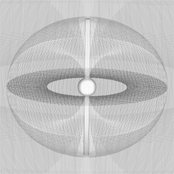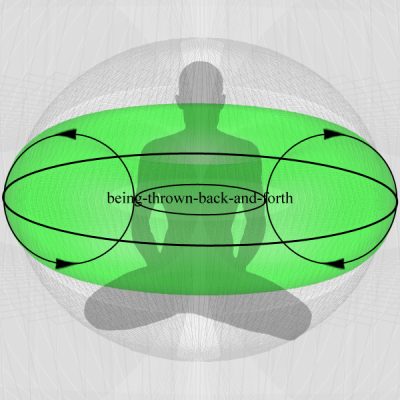




































representational inquiry regarding meaning » reality » self/world dynamic
As part of the experiencer-experiencing-experienced axis, the W-node is properly just experiencing as such, but as we are already involved in a discursive space of meaning involving particular experiencers experiencing experienced particulars, we paradigmatically understand experiencing as such in terms of experiencing as (self/world) dynamic, hence the green color. (The torus = experiencing, and the green color = dynamic.)
This self/world dynamic is the discursive activity of meaning-making. It's dialogical in nature, indicating an interdependent, reciprocal relationship between self and world—a process of being thrown back-and-forth between self and world. This dialogue makes meaning by opening a discursive space in which intelligibility occurs. This discursive, dialogical activity counts as the process of interpreting reality meaningfully. It's an hermeneutic process—a dialogue between part and whole, text and context—where self is paradigmatically the part and world is paradigmatically the whole.
The diagrammatic components of the W-node torus include its inner horizon (the donut hole), its outer horizon, and the vertically-oriented loop that forms the body of the donut as it rings the axis. These parts correspond to experiencing as self (inner horizon donut hole), where the dynamic moves toward parts, experiencing as world (outer horizon), where the dynamic moves toward wholes, and experiencing as dynamic (vertically-oriented loop), where the dynamic moves dialogically, actively integrating self and world, part and whole.
W is an odd letter insofar as it was added to the alphabet relatively recently. It can't be unambiguously traced back to any letter of the original alphabet. But it does have some affinities with a few of those original letters. First, graphically, the Phoenician letter shin resembles a modern W. The letter shin likely originally represented either a bow (the hunting tool) or a tooth. But the letter shin, since it appears between resh/R and tav/T in the early alphabets, is more naturally associated with the letter S. Yet the original alphabets contained three letters that might be associated with S: shin, samekh, and tzadi, and samekh and tzadi each have no obvious Latin alphabet decendent.
While the letter shin bears a graphic resemblance to our W, the closest affinity with W in the early alphabets/abjads is the letter vav which occupies the position in the original abjad that our the letter F now occupies. It is thought that vav originally meant mace or hook. And the letter vav commonly gets transliterated as V or W, as the pronunciation of vav was likely close to a W sound. Additionally, V and W have natural affinities with our letter U, all of which emerged from the Greek upsilon—and none appeared in the original Semitic abjads, except insofar as they stood in place of vav, today's F.
So, W has affinities with S—directly with shin (according to shape), and indirectly (through shin) with samekh and tzadi (as variants of S), and it has affinities with F along with U and V.
Samekh and vav have an affinity between them. Vav's numerical equivalent is 6 while samekh's is 60. And since there is no modern letter in the place of samekh/60, and because of the numerical connection with vav, a good place for W is between N (50) and O (70), taking for itself the numberic value of 60, while V takes 600, leaving U in line with the Archaic Greek's placement of Upsilon. The alternative would be to place W in place of tzadi/90. Again, because of it's association with F/6 and V/600, W is more akin to 60 than 90.
The original image used for samekh was that of an Egyptian djed, or pillar, and the original image used for tzadi was that of a reed, likely of papyrus. Moreover, it is possible that a djed was originally a pillar made of bunched reeds (Pinch, G. [2002] Handbook of Egyptian Mythology, pg. 127), connecting the two symbols. Also, "some early uses of the djed symbol imply that it could be thought of as a pillar holding the sky above the earth" (ibid., 128). It is between the earth and sky that intelligibility occurs by rhythmic measure. W is thus best suited to take the place of a bound bunch of reeds (the graduated djed symbol) rather than a single clump of reeds, as it represents the dynamic relationship between self and world that holds open (supports) a "space" for meaning's occurrence. So, again, W takes the place of samekh/60/djed/pillar of support.
Aside from the position W holds in the alphabet, here are a couple ways we might creatively conceive of W's meaning. W can be thought of as a bow (the original pictogram for the letter shin which resembles a W in shape). A bow holds tension—in this case the tension between self and world. This tension is that which allows the system to maintain its integrity as an interconnected system. So, if self and world are thought of as two sides of the same coin, let's say, the tension of W is what allows these two sides to be pulled apart from one another while remaining connected. (Heraclitus [DK 51]: "They do not understand how that which differs with itself is in agreement: harmony consists of opposing tension, like that of the bow and the lyre.") Also, W's connection with the mace or hook of vav/F might be thought of in terms of the ego-Self axis—the tether tying together the conscious and predominantly unconcious aspects of the psyche—or the golden thead maintaining the connection between self and world. Finally, and this one's even more of a stretch (no pun intended), we might think of this link that W makes—either as bow or mace/hook—in terms of reciprocity. There's a reciprocal movement between self and world, or ego and Self. This movement is dialogical, going back-and-forth. So, graphically, a W is like this dialogical movement as re-ci-pro-ci-tas (back-and-forth-ness).
